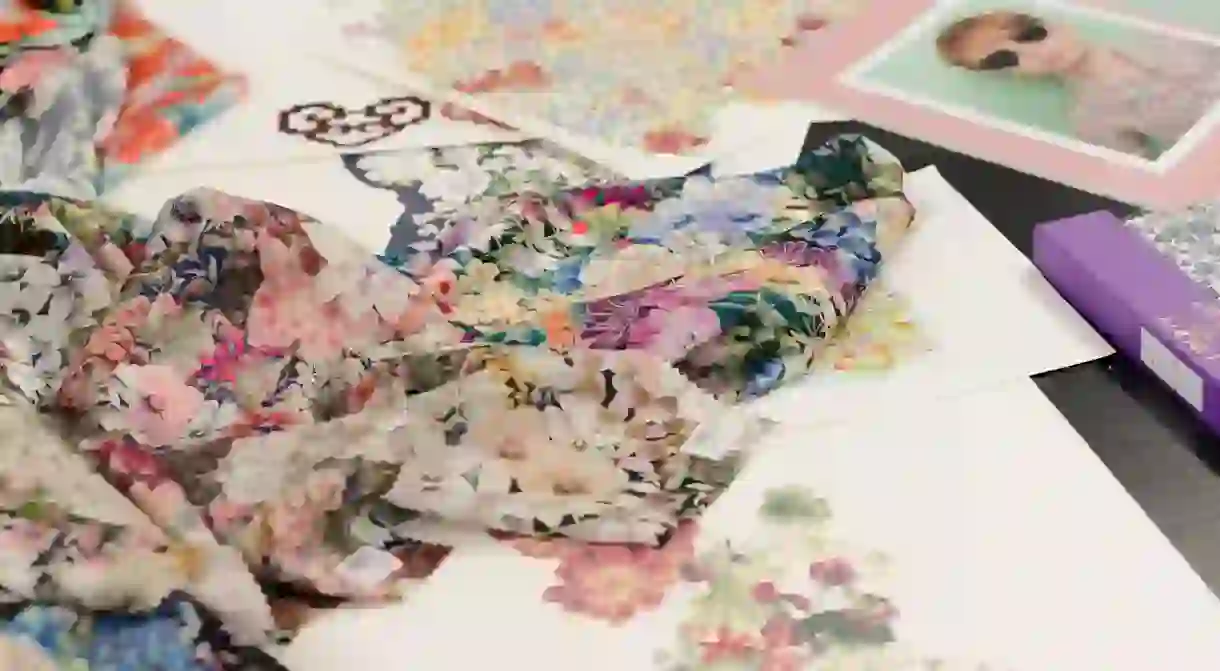Behind the Collection With Liberty London's Print Design Team

Instead of chasing trends, the print design team at Liberty London draws inspiration from art history, cultural icons and a vast fabric archive to create its collections. Designer Ffion Griffith explains the enduring appeal of the department store famed for its mock Tudor exterior and bold, floral designs.

“If a print is beautiful, exquisite, and if it has taken time to create, then it will always be relevant,” says Ffion Griffith, the artist behind many of Liberty’s most memorable new fabric designs.
Along with the rest of the print team, she works on collections two years ahead of their release. “Our work isn’t governed by industry trends,” she says. “Instead, we put a lot of time into researching meaningful themes that we want to represent each season.”
The in-house archive, home to over 40,000 items, is a constant source of inspiration. From the 1880s, undyed fabric was printed with colourful, ‘Oriental’ patterns and stamped with the slogan: Made in England. It’s a look that established the brand’s Eastern-bazaar fashion and homeware aesthetic, and one that’s still recognisable today.

“Every printed product in store starts as a hand-drawn artwork,” says Griffith. “Everyone on the team has a different preferred medium to work with, whether it be watercolour paint, oils or even collage. It’s a very creative and considered process.”
This practice means it takes from 12 to 15 weeks to complete a collection, with the team working from complex research findings to inform its direction. Past collections have begun by looking at the work of eccentric English muses – from King George IV, whose interior choices informed the look of Brighton Pavilion, to John Lennon, who wore a Liberty print shirt on stage in the 1970s, and modern-day supermodel Lily Cole.

“It’s important to us to look across a range of eras when starting a collection,” says Griffith. “But for Christmas 2018, we focussed on the Liberty building itself.
“It was crafted using historical warships and, if you look closely, you can see woodland creatures carved into the beams. We created a story about them waking up at night and causing mischief, and we worked with a writer who brought each animal to life through poetry.”

The importance of the archive, and of the brand’s illustrious history, to the creative process can’t be overstated. “We often look back in order to look forward,” says Griffith. “The archive doesn’t really have a set look because so many different artists have contributed to collections in the past.
“There’s an incredible array of Indian paisley paintings that we draw from a lot, but sometimes it takes longer to work a new design up from a vintage piece than it does to start from scratch. When you use small elements of an existing pattern, it leaves gaps that need to be filled.”

Griffith and the team create two 60-print collections a year, which are worked into a minimum of five palettes associated with the theme. Colouring sessions are an important part of the process and can result in up to 100 variations per design. Eventually, the prints are applied to fabric and products to sell in-store.
Most famous is the Betsy, a feminine floral motif first created in 1933 but subtly reimagined year after year to remain at the forefront of the collection. It takes pride of place in the department store’s haberdashery, a treasure trove of dressmaking essentials and add-ons.

“People often associate Liberty with 1930s florals,” says Griffith. “There’s particular demand for craft and artisanal creations at the moment and it’s something that’s so present in our archive. It’s amazing to see how relevant things remain. Some of what we uncover looks so modern.”
It’s this timelessness that keeps high-fashion labels interested in collaborating with Liberty. Its history of capsule collections includes Yves Saint Laurent, Manolo Blahnik, Paul Smith and, most recently, Spanish clothing and accessories label Loewe, which incorporated William Morris textiles into its autumn/winter 2018 collection.

“Our job, and our day-to-day challenge, is to make Liberty print relevant,” says Griffith. “We have a lot of freedom to work on our own ideas, to produce original sketches and paintings, and to really shape a collection.
“As long as we create something that’s original and true to the iconic Liberty aesthetic, I think it will always be prolific.”














